Complete Solutions to Exercises of chapter REFRACTION OF LIGHT BY PLANE SURFACES of Class 12 book with complete answers and questions
| Class 12 | PHYSICS |
| Chapter | REFRACTION OF LIGHT BY PLANE SURFACES |
| CP SINGH | Exercises |
| Number Of Questions | 100 |
| Academic Year | 2023-24 |
When light moves from one medium to another
(i) the frequency of light remains same and wavelength changes
(ii) refractive index of a medium is the ratio of speed of light in vacuum and speed of light in medium
(iii) refractive index of a medium is the ratio of wavelength of light in vacuum and wavelength in medium
(iv) for denser medium, the value of refractive index is larger01:53View Solution(i) `mu=(c)/(v_m)=(vlambda)/(vlambda_m)`
where
c: speed of light in vacuum
`v_m:` speed of light in medium
`lambda:` wavelength in vacuum
`lambda_m`: wavelength in medium
`upsilon:` frequency of light
(ii) `mu=((epsilonmu)/(epsilon_0mu_0))^(1/2)`
where `epsilon:` electric permittivity in free space
`epsilon:` electric permittivity in medium
`mu_0:` magnetic permeability in free space
`mu:` magnetic permeability in medium
(iii) `mu=A+B/lambda^2`, where A and B are constants
(iv) In case of VIBGYOR, wavelength increases from violet to red, refractive index decreases from violet to red. Wavelength for red-colour is maximum whereas refractive index is maximum for violet colour.02:21View SolutionElectromagnetic radiation of frequency `n`, wavelength `lambda`, travelling with velocity v in air, enters a glass slab of refractive index `mu`. The frequency, wavelength and velocity of light in the glass slab will be respectively
01:26View SolutionAbsolute refractive indices of glass and water are `3//2` and `4//3`. The ratio of velocity of light in glass and water will be
01:19View SolutionLight travels through a glass plate of thickness t and having refractive index n . If c is the velocity of light in vacuum, the time taken by the light to travel this thickness of glass is
01:49View SolutionThe refractive index of water, glass and diamond are `1.33`, `1.50`, `2.40` respectively. The refractive index of diamond relative to water and of glass relative of diamond, respectively are nearly
06:45View SolutionA ray of light passes through four transparent media with refractive indices`mu_1`,`mu_2`,`mu_3` and `mu_4` as shown in the figure. The surfaces of all media are parallel. If the emergent ray CD is parallel to the incident ray AB, we must have
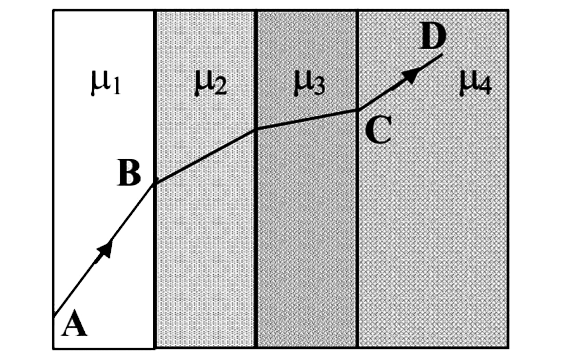 03:14View Solution
03:14View SolutionA ray of light is incident at the glass-water interface at an angle I, it emerges fimally parallel to the surface of water, the the value of `mu_g` would be
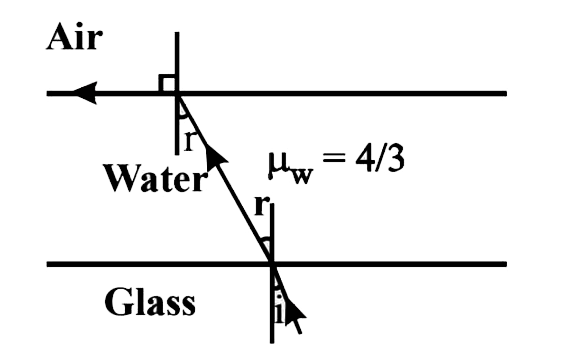 02:16View Solution
02:16View SolutionIf `._imu_j` represnts the refractive index when a ray of light goes from medium i to j, then the product `._2mu_1xx._1mu_3xx._3mu_4` is equal to
01:34View SolutionThe bottom of a container filled with liquid appears slightly raised because of
01:17View SolutionA plane glass slab is placed over various coloured letters. The letter which appears to be raised the least is
02:30View SolutionA transparent cube of `15 cm` edge contains a small air bubble. Its apparent depth when viewed through one face is `6 cm` and when viewed through the opposite face is `4 cm`. Then the refractive index of the material of the cube is
04:01View SolutionA man standing in a swimming pool looks at a stone lying at the bottom. The depth of the swimming pool is h. At what distance from the surface of water is the image of the stone formed -
02:02View SolutionA fish in water sees an object which is `24cm` above the surface of water. The height of the object above the surface of water that will appear to the flash is `(mu=4//3)`
02:05View SolutionA bird flies down vertically towards a water surface. To a fish inside the water, vertically below the bird, the bird will appear to
(i) be farther away than its actual distance
(ii) be closer than its actual distance
(iii) move faster than its actual speed
(iv) move slower than its actual speed02:17View SolutionA ball is dropped from a height of `20m` above the surface of water in a lake. The refractive index of water is `4//3`. A fish inside the lake, in the line of fall of the ball, is looking at the ball. At an instant, when the ball is `12.8m` above the water surface, the fish sees the speed of ball as `(g=10m//sec^2)`
04:24View SolutionA fish rising up vertically toward the surface of water with speed `3ms^(-1)` observes a bird diving down vertically towards it with speed `9ms^(-1)` . The actual velocity of bird is
 02:28View Solution
02:28View SolutionP is a point on the axis of a concave mirror. The image of P, formed by the mirror, coincides with P. A rectangular glass slab of thickness t and refractive index `mu` is now introduced between P and the mirror. For the image of P to coincide with P again, the mirror must be moved
02:52View SolutionA vessel of depth d is half filled with a liquid of refractive index `mu_1` and the other half is filled with a liquid of refractive index `mu_2`. The apparent depth of the vessel, when looked at normally, is
02:43View SolutionA plane mirror is placed at the bottom of a tank containing a liquid of refractive index `mu`. P is a small object at a height h above the mirror. An observes P and its image in the mirror. The apparent distance between two will be
 03:10View Solution
03:10View SolutionAn object is placed `20cm` in front of a block of glass `10cm` thick having its farther side silvered. The image is formed `23.2cm` behind the silvered face. The refractive index of glass is
03:33View SolutionA slab of glass of refractive index `1.5` and thickness `3cm` is placed with the faces perpendicular to the principle axis of a concave mirror. If the radius of curvature of the mirror is `10cm`, the distance at which an object must be placed from the mirror so that the image coincides with the object is
02:39View SolutionA microscope is focused on a mark on a piece of paper and then a slab of glass of thickness `3cm` and refractive index `1.5` is placed over the mark. How should the microscope be moved to get the mark in focus again ?
03:17View SolutionA container is filled with water `(mu=1.33)` upto a height of 33.25 cm. A concave mirror is placed 15cm above the water level and the image of an object placed at the bottom is formed 25 cm below the water level. Focal length of the mirror is
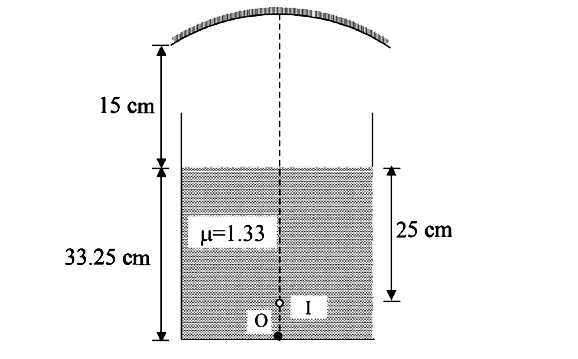 03:47View Solution
03:47View Solution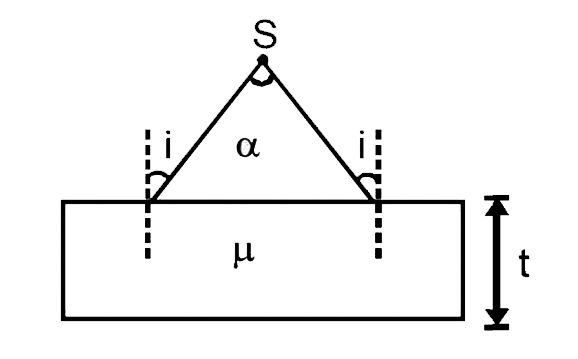
A diverging beam of light from a point source S having devergence angle `alpha`, falls symmetrically on a glass slab as shown. The angles of incidence of the two extreme rays are equal. If the thickness of the glass slab is t and the refractive index n, then the divergence angle of the emergent beam is02:56View SolutionA concave mirror is placed at the bottom of an empty tank with face upwards and axis vertical. When sunlight falls normally on the mirror, it is focussed at distance of `32cm` from the mirror. If the tank filled with water `(mu=4//3)` up to a height of `20cm`, then the sunlight will now get focussed at
03:16View SolutionA pile driven into the bottom of a lake extends `3m` above the bottom of a lake and `1m` above the surface of water `(._amu_omega)=4//3`. If the sun is `30^@` above the horizon, then the length of the shadow of the pile on the bottom is approximately
03:58View SolutionA concave mirror with its optic axis vertical and mirror facinig upward is placed at the bottom of the water tank. The radius of curvature of the mirror is 40 cm and refractive index for water `mu=4//3` . The tank is 20 cm deep and if a bird is flying over the tank at a height of 60 cm above the surface of water, find the position of image of the bird.
06:20View SolutionThe mean distance of sun from the earth is `1.5xx10^8km`. The time taken by light to reach earth from the sun is
01:23View SolutionA ray of light composed of blue and red light is incident on a parallel plate of glass. When the light emerges from the other side of the plate, the two coloured beams will appear at
01:55View SolutionWhen a ray of light enters a water filled glass tank from a glass face making a non-zero angle to the normal, the emergent ray from the opposite face will follow a path which is
01:45View SolutionLight passes through a glass slab with parallel sides and thickness t. If i and r the angles of incidence of refraction, the lateral displacement is
03:43View SolutionA ray of light is incident on a surface of glass slab at an angle `45^@`. If the lateral shift produced per unit thickness is `1//sqrt3`, the angle of refraction produced is
02:03View SolutionTwo transparent slabs have the same thickness as shown in figure. One in made of material A of refractive index 1.5. The other is made of two materilas B and C with thickness in the ratio 1:2. The refractive index of C is 1.6. If a monochromatic parallel beam passing through the slabs has the same number of wavelengths inside both, the refractive index of B is
 03:00View Solution
03:00View SolutionA ray of light is incident on the surface of a glass plate of thickness `t`. If the angle of incidence `theta` is small, the emerging ray would be displaced side ways by an amount
(Take `n` = refractive index of glass)04:57View SolutionMaximum lateral displacement of ray light incident on a slab of thickness t is
01:30View SolutionTwo optical media of refractive indices `n_1` and `n_2` contain x and y waves of the same colour in the same thickness. Then their relative refractive index `n_1//n_2`
02:05View SolutionRefractive index of air is `1.0003.` The correct thickness of air column which will have one more wavelength of yellow light `(6000 Å)` than in the same thickness in vacuum is
06:57View SolutionIf `hat(i)` denotes a unit vector along incident light ray, `hat (r)`a unit vector along refracted ray into a medium of refraction index `mu` and `hat (n)` unit vector normal to boundary of medium directed towards incident medium, then law of refraction is
03:25View SolutionThe apparent depth of water in cylindrical water tank of diameter `2R cm` is reducing at the rate of `x cm // min ` when water is being drained out at a constant rate. The amount of water drained in `c.c.` per minute is `(n_(1)=` refractive index of air, `n_(2)=` refractive index of water )
04:27View SolutionLet the x-z plane be the boundary between two transparent media. Media 1 in `zge0` has refractive index of `sqrt2` and medium 2 with `zlt0` has a refractive index of `sqrt3`. A ray of light in medium 1 given by the vector `vecA=6sqrt3hati+8sqrt3hatj-10hatk` in incident on the plane of separation. The angle of refraction in medium 2 is
04:21View SolutionAn observer can see through a pin-hole the top end of a thin rod of height h, placed as shown in the figure. The height of beaker is `3h` and its radius is h. When the beaker is filled with a liquid up to a height `2h`, he can see the lower end of the rod. Then the refractive index of the liquid is
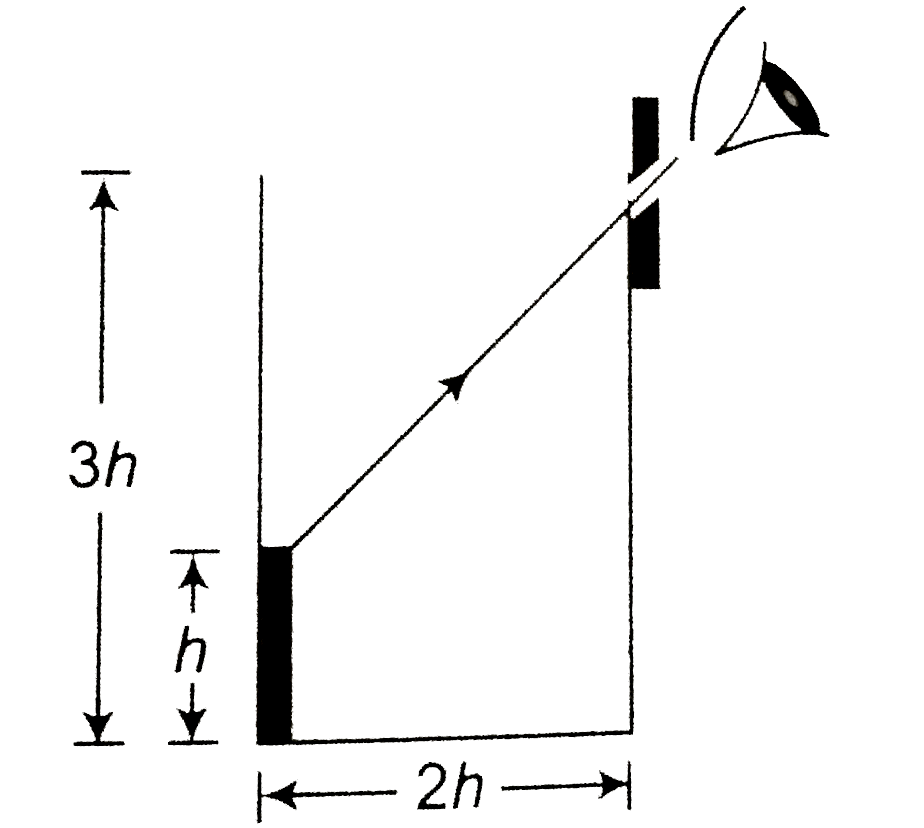 07:43View Solution
07:43View SolutionThe speed of light in medium A is `2.0xx10^8m//sec` and that in medium B is `2.4xx10^8m//sec`. The critical angle of incidence for light tending to go from medium A to medium B is
03:12View SolutionWhen a ray is refracted from one medium into another, the wavelegths changes from `6000Å` to `4000Å`. The critical angle for a ray from the second medium will be
03:04View SolutionA ray of light travelling inside a rectangular glass block `(mu=sqrt2)` is incident on the glass-air surface at an angle of incidence of `45^@`. The refractive index of air is 1. The ray will
06:34View SolutionCritical angle of light passing from glass to water is minimum for
03:05View SolutionCritical angle is minimum when a light ray passes from
03:55View SolutionA ray of light from a denser medium strikes a rarer medium at angle of incidence `i`. The refrected and the refracted rays make an angle of `90^@` with each other. The angles of reflection and refraction are r and `r^'` respectively. The critical angle is
(i) `sin^-1(tanr)`
(ii) `sin^-1(tani)`
(iii) `sin^-1(tanr)`
(iv) `tan^-1(tani)`06:26View SolutionA ray of light travelling in a transparent medium falls on a surface separating the medium from air, at an angle of incidence of `45^@`. The ray undergoes total interal reflection. If `mu` is the refractive index of the medium with respect to air, select the possible values of `mu` from the following:
(i) `1.3`
(ii) `1.4`
(iii) `1.5`
(iv) `1.6`03:54View SolutionA diver inside water sees the setting sun at `(sin^-1.(3)/(4)=49^@) (mu_omega=4//3)`
02:46View SolutionA, B and C are three optical media of respective critical angles `C_1`, `C_2` and `C_3`. Total internal reflection of light can occur from A and B and also from B to C but not from C to A. Then the correct relation between critical angles is
01:19View SolutionA ray of light travelling in water is incident on its surface open to air. The angle of incidence is `theta`, which is less than the critical angle. Then there will be
04:59View SolutionWhite light is incident on the interface of glass and air as shown in figure. If green ligth is just totally internally reflected then the emerging ray in air contains
 02:06View Solution
02:06View SolutionFigure shows a mixture of blue, green and red coloured rays incident normally on a right angled prism. The critical angles of the material of the prism for red, green and blue are `46^@`, `44^@` and `43^@` respectively. The arrangement will separate
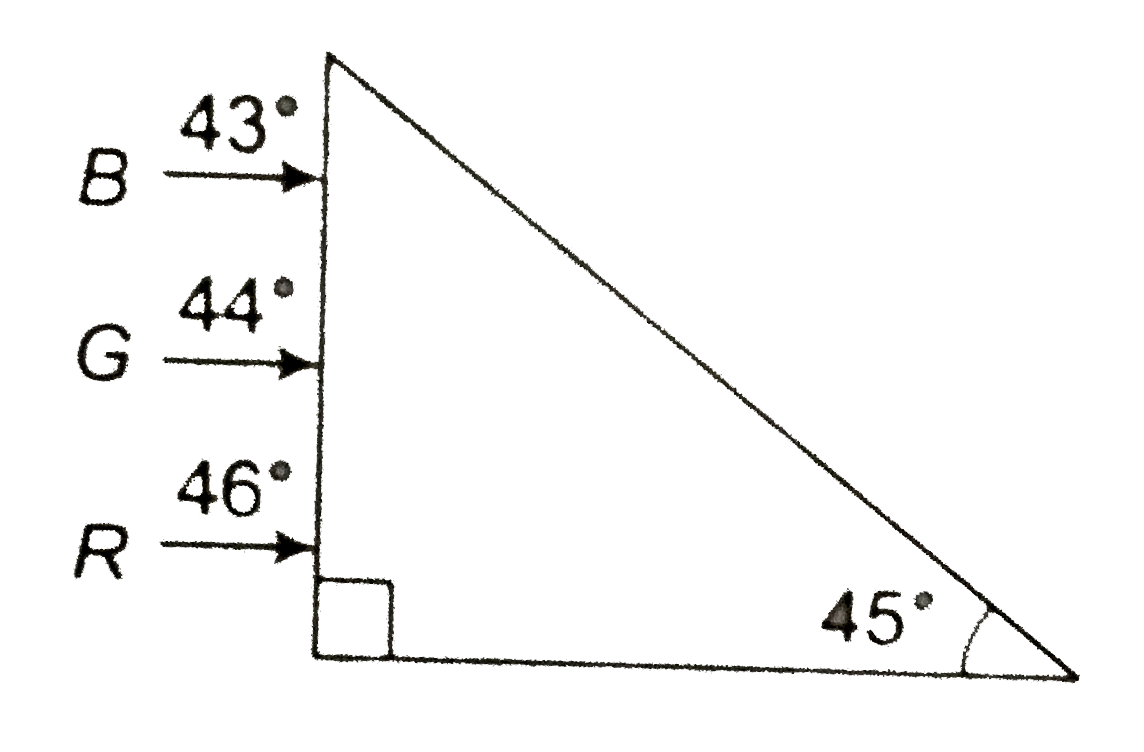 01:34View Solution
01:34View SolutionAn air masked eye placed inside water refractive index, `mu` sees the outside world. The vertex angle of the cone in which the eye will see the outside world is
02:36View SolutionA fish looking up through the water sees the outside world contained in a circular horizon. If the refractive index of water is `4//3` and the fish is `12cm` below the surface, the radius of this circle in cm is
03:18View SolutionA point source of light is placed `4m` below the surface of a liquid of refractive index `5//3`. The minimum diameter of a disc, which should be placed over the source, on the surface of the liquid to cut off all light out of water, is
03:12View SolutionA diver in a lake wants to signal his distress to a person sitting on the edge of the lake flashing his waterproof torch. He should direct the beam
03:44View SolutionA light beam is travelling from Region `I` to `IV` (figure). The refractive index in regionals `I,II,III` and `IV` are `n_0=(n_0)/(2)`(n_0)/(6) and (n_0)/(8)` respectively. The angle of incidence `theta` for which the beam just misses entering region IV is- `
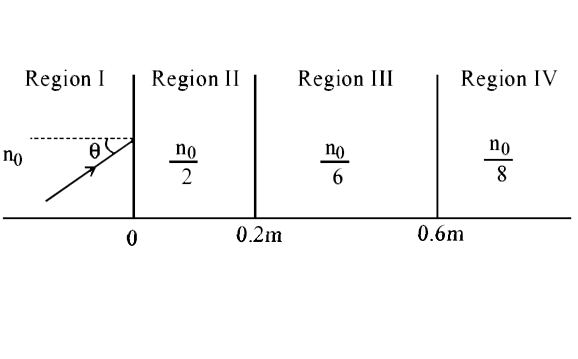 03:09View Solution
03:09View SolutionA transparent solid cylindrical rod has a refractive index of `(2)/(sqrt3)` .It is surrounded by air. A light ray is incident at the mid-point of one end of the rod as shown in the figure. The incident angle `theta` for which the light ray grazes along the wall of the rod is:
`
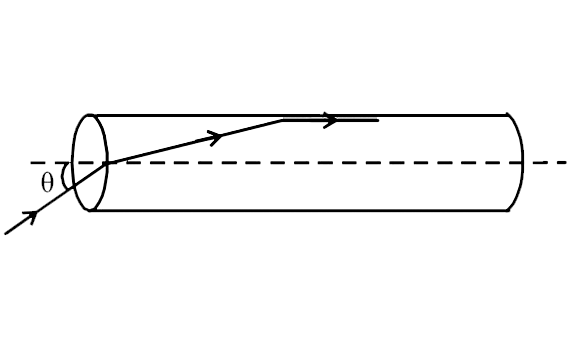 02:49View Solution
02:49View SolutionLight enters at an angle of incidence in a transparent rod of refractive index n. For what value of the refractive index of the material of the rod the light once entered into it will not leave it through its lateral face whatsoever be the value of angle of incidence.
09:24View SolutionWhen light is incident on a medium at angle i and refracted into a second medium at an angle r, the graph of `sin r` versus `sin i` is as shown. From this one can conclude that

(i) the velocity of light in second medium is `sqrt3` times the velocity of light in the first medium
(ii) the velocity of light in the first medium is `sqrt3` times the velocity of ligth in second medium
(iii) the critical angle of the two media is given by `sin i_C=1sqrt3`
(iv) the critical anlge of the two media is given by `sin i_C=1sqrt2`02:31View SolutionA rectangular slab ABCD, of refractive index `n_1` , is immersed in water of refractive index `n_2(n_1 lt n_2)`. A ray of light is incident at the surface AB of the slab as shown in Fig. Find the maximum value of angle of incidence `alpha_(max)`, such that the ray comes out only from the other surface CD.
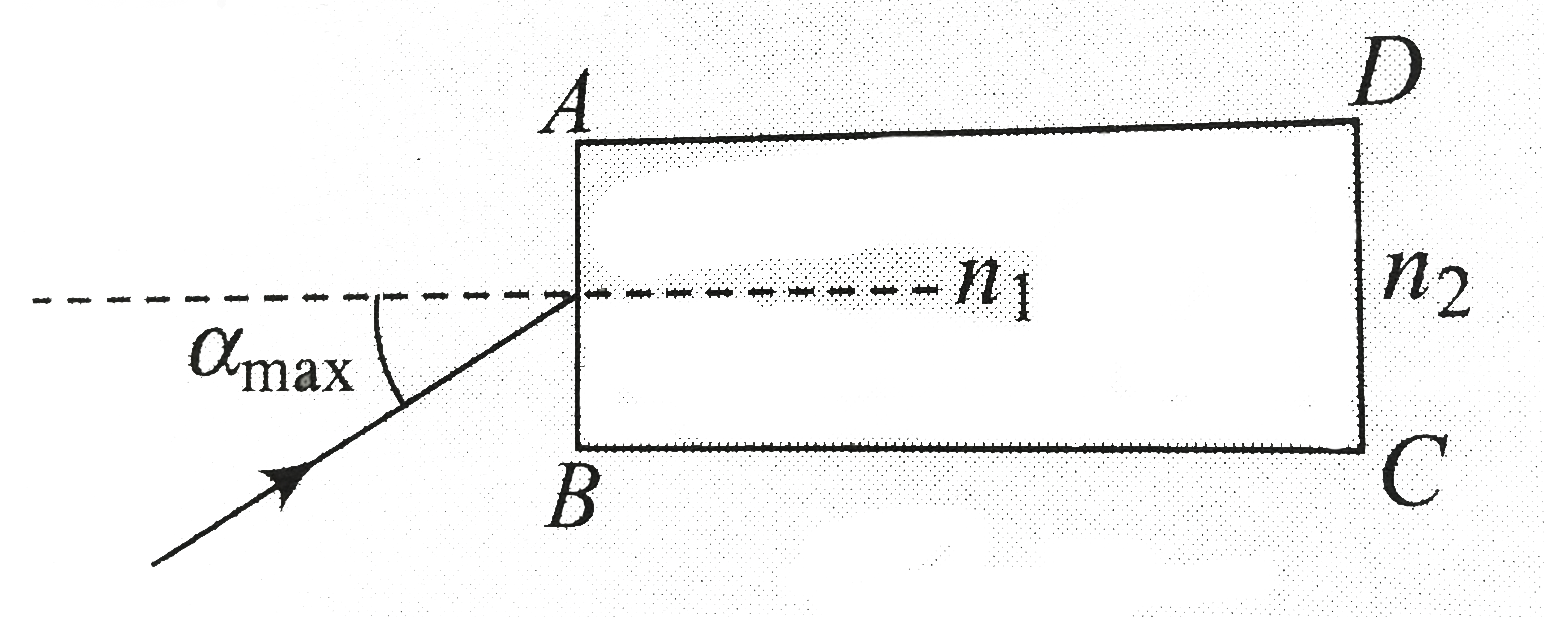 05:57View Solution
05:57View SolutionA ray of light travels from an optically denser to rarer medium. The critical angle of the two media is C. The maximum possible deviation of the ray will be
04:00View SolutionA ray of light travels from a medium of refractive index `mu` to air. Its angle of incidence in the medium is `i`, meansured from the normal to the boundary , and its angle of deviation is `delta. delta` is plotted against `i`. Which of the following best represents the resulting curve ?
05:46View SolutionThe reason for shining of air bubble in water is
01:53View SolutionWhich of the following is not due to total internal reflection ?
03:31View SolutionConsider telecommunication through optical fibres. Which of the following statements is not true?
01:16View SolutionPick out the correct staments about optical fibres from the following:
S1: Optical fibres are used for the transmission of optical signals only
S2: Optical fibres are used for transmission of optical electrical signals
S3: The intensity of light signals sent through optical fibres suffer very small loss
S4: Optical fibres effectively employ the principle of multiple total internal reflections
S5: Optical fibres are glass fibres coated with a thin layer of a material with lower refractive index01:47View SolutionWhich of the following options are correct regarding prism?
03:12View SolutionWhen a ray of light is refracted by a prism such that the angle of deviation is minimum, then
01:59View SolutionDeviation `delta` produced by a prism of angle A, which is assumed to be small, made of a material of refractive index `mu` is given by
01:31View SolutionThe refracting angle of a prism is `A` and refractive index of the material of the prism is `cos(A//2)`. The angle of minimum deviation is
04:12View SolutionIf the refracting angle of a prism is `60^@` and the minimum deviation is `30^@`, then the angle of incidence is
01:30View SolutionA ray of light passes through an equilateral glass prism in such a manner that the angle of incidence is equal to the angle of emergence and each of these angles is equal to `3//4` of the angle of the prism. The angle of deviation is
03:37View SolutionA prism of apex angle `A=60^@` has the refractive index `mu=sqrt2.` The angle of incidence for minimum deviation is
01:23View SolutionA parallel beam of monochromatic light is incident at one surface of a equilateral prism. Angle of incidence is `55^(@)` and angle of emergence is `46^(@)`. The angle of minimum deviation will be
02:50View SolutionA ray of light is incident normally on one of the faces of a prism of apex angle 30 degree and refractive index sqrt2. The angle of deviation of the ray is…degrees.
03:10View SolutionA ray of light is incident normally on one face of an equilateral prism of refractive index `1.5`. The angle of deviation is: (Given `sin^-1.(2)/(3)=42^@`)
03:35View SolutionA prism having refractive index `sqrt2` and refractive angle `30^@` has one of the refractive surfaces polished. A beam of light incident on the other surfaces will trace its path if the angle of incidence is
01:26View SolutionA ray falls on a prism `ABC(AB=BC)` and travels as shown in adjoining figure.The minimum refraction index of the prism material should be -
04:25View SolutionA glass prism of refractive index 1.5 is immersed in water (refractive index 4/3). A light beam incident normally on the face AB is totally reflected to reach on the face BC if.
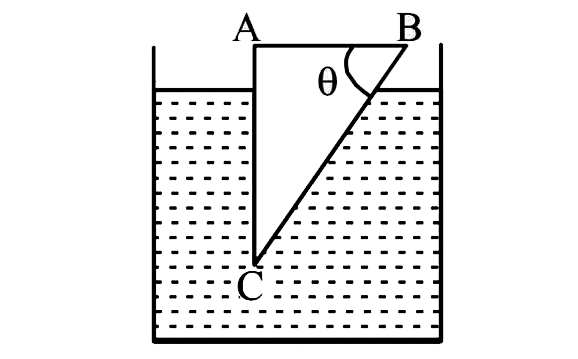 02:47View Solution
02:47View SolutionA prism of angle `60^@` deviates a ray of light through `32^@` for two angles of incidence which differ by `12^@`. The angles of incidence are
01:44View SolutionThe maximum value of index of refraction of a material of a prism which allows the passage of light through it when the refracting angle of prism is A is
06:19View SolutionTwo beams of red and violet colours are made to pass separately through a prism (angle of the prism is ` 60degree`). In the position of minimum deviation, the angle of refraction will be
01:38View SolutionWhen a glass prism of refracting angle `60^(@)` is immersed in a liquid its angle of minimum deviation is `30^(@)`. The critical angle of glass with respect to the liquid medium is
04:26View SolutionAngle of prism is `A` and its one surface is silvered. Light rays falling at an angle of incidence `2 A` on first surface return back through the same path after suffering reflection at second silvered surface. Refraction index of the material of prism is
04:20View SolutionThree prisms 1, 2 and 3 have the prism angle `A = 60^(@)`, but their refractive indices are respectively 1.4, 1.5 and 1.6. If `delta_(1), delta_(2), delta_(3)` be their respective angles of deviation then
02:19View SolutionA ray of light is incident at small angle I on the surface of prism of small angle A and emerges normally from the oppsite surface. If the refractive index of the material of the prism is mu, the angle of incidence is nearly equal to
01:42View SolutionA light ray is incident on a prism in minimum deviation position and suffers a deviation of `40^@`. If the shaded half of the prism is removed off, then the same ray will suffer a deviation of
 02:53View Solution
02:53View Solution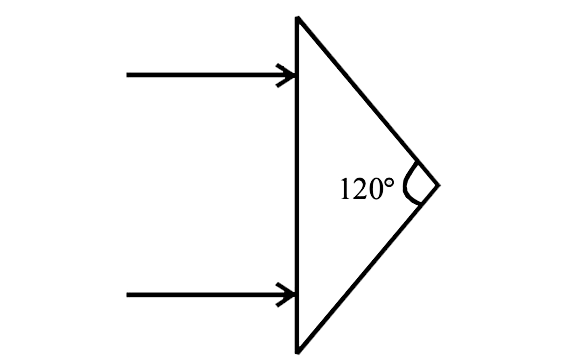
An isosceles prism of angle 120degree has a refractive index 1.44. Two parallel monochromatic rays enter the prism parallel to each other in air as shown. The rays emerge from the opposite faces03:10View SolutionTwo parallel light rays are incident at one surface of a prism of refractive index `1.5`. What is the angle between the rays as they emerge? `sin^-1(0.75)=48.5^@`
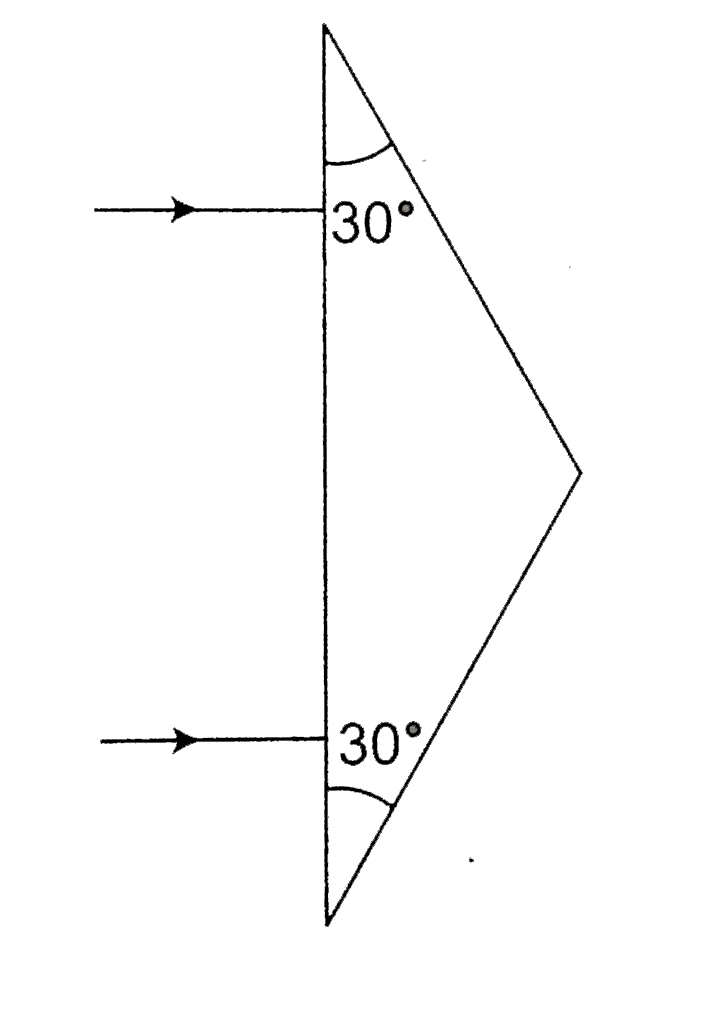 04:50View Solution
04:50View Solution`P` is small angled prism of angle `3^(@)` made of a material of refractive index `1.5`. A ray of light is incident normally to the mirror as shown in figure. `M` is a plane mirror. The angle of deviation for the ray reflected from the mirror `M` with respect to the incident ray is :
 02:17View Solution
02:17View SolutionLight is incident normally on face AB of a prism as shown in Figure. A liquid of refractive index `mu` is placed on face AC of the prism. The prism is made of glass of refractive indes `3//2` . Find the limits of `mu` for which total internal reflection takes place on the face AC.
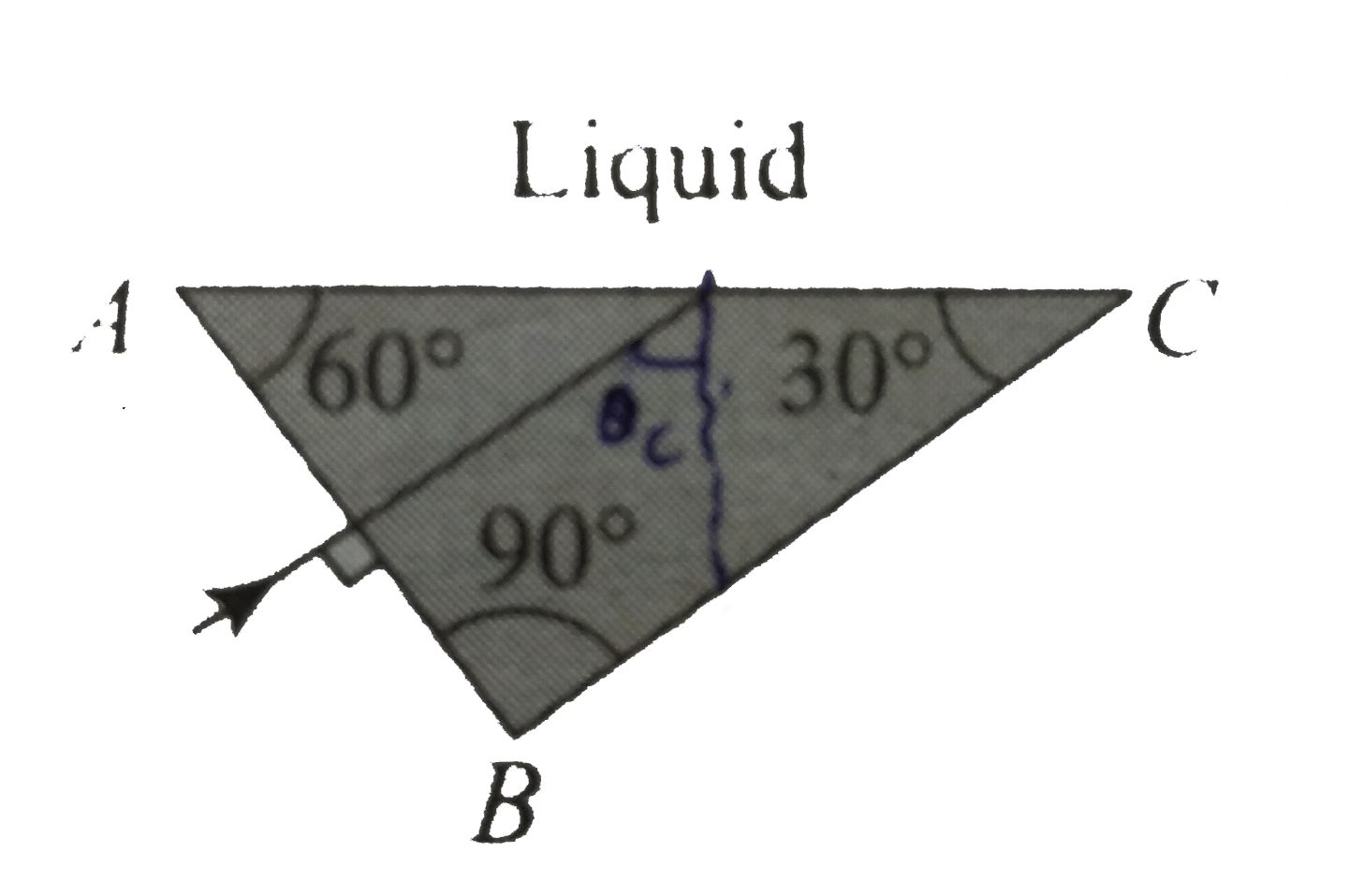 04:26View Solution
04:26View SolutionA beam of white light is incident on a hollow prism of glass. Then
 01:17View Solution
01:17View SolutionFor a small angled prism, angle of prism `A` of minimum deviation`(delta)` varies with the refractive index of the prism as shown in the graph
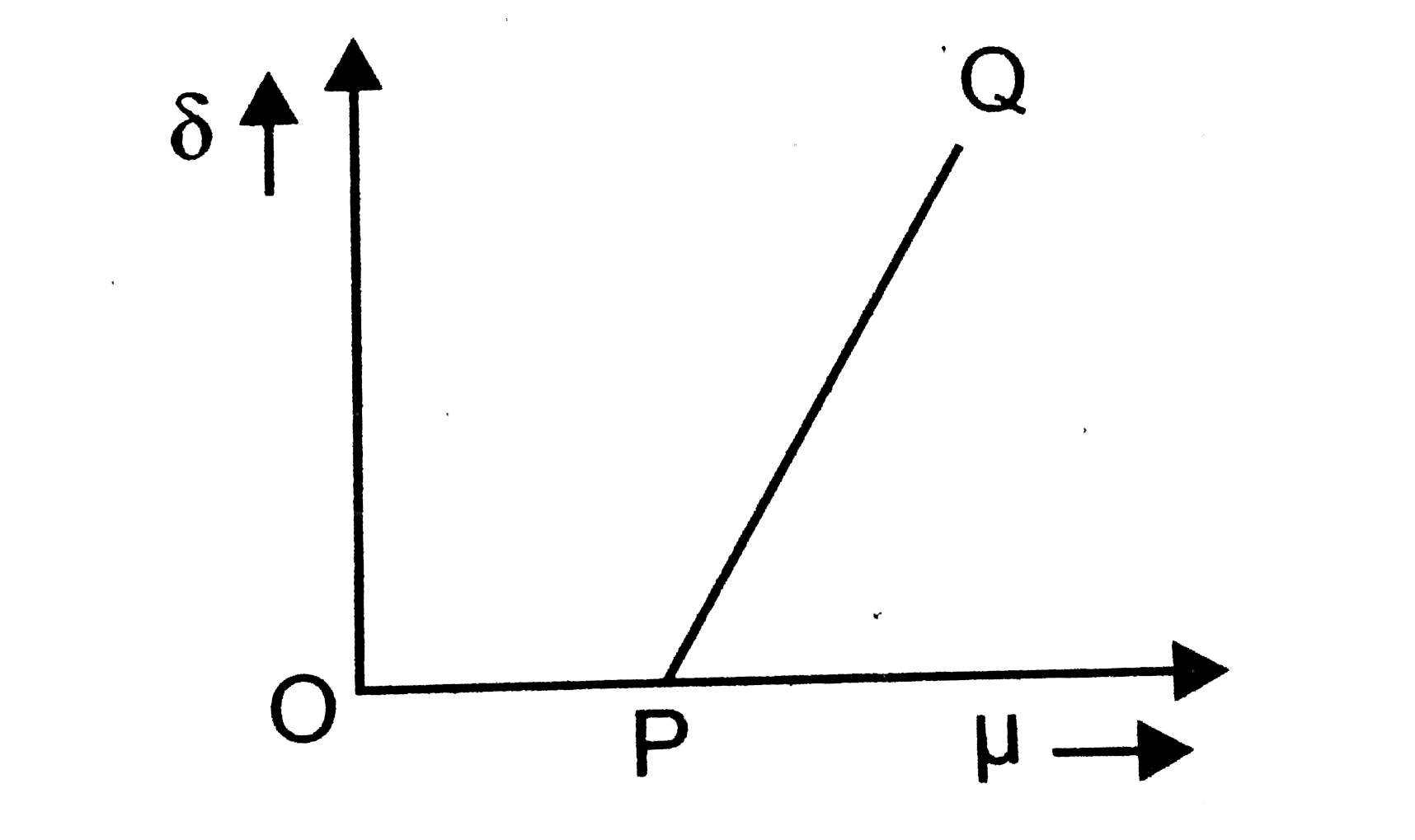 02:10View Solution
02:10View SolutionThe graph between angle of deviation `(delta)` and angle of incidence (i) for a triangular prism is represented by
03:20View SolutionA narrow beam of white light enters slab having parallel faces.
01:46View SolutionA medium is said to be dispersive if
02:28View SolutionDispersion can take place for
02:16View Solution
Exercises questions and complete solutions for chapter REFRACTION OF LIGHT BY PLANE SURFACES of CP SINGH PHYSICS (HINGLISH) of Class 12
